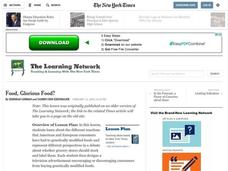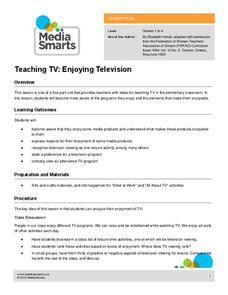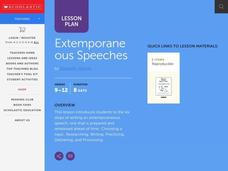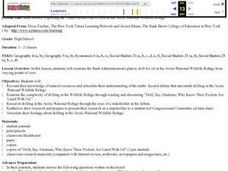Curated OER
Lab Experiments in Nutrition
Looking for authentic hands-on nutritional experiments? High schoolers will perform experiments to test for the presence of vitamin C in several solutions as well as the effect of caffeine on Daphnia. They will also consider the...
Howard Hughes Medical Institute
Survival of the Fittest - Variations in the Clam Species Clamys sweetus
It's not often that you come across a clever laboratory activity that is both imaginative and comprehensive! Using M&M's and Reese's peanut butter candies to represent two different clam species, young biologists test for "relative...
Curated OER
Miss America
The first part of this article by PBS on the Miss America pageants can be used in a health class when it's time to talk about body image. There are links to related articles. There are some great questions for discussion. There are ideas...
Hawaiʻi State Department of Education
Picture Poetry
What a fun idea! The class discusses, and then writes free-verse poems using sensory detail. They get into small collaborative writing teams to compose their poems. Next, they pantomime the actions from the poem while their teammates...
Curated OER
Graph It!
There is more than one way to represent data! Learners explore ways to represent data. They examine stacked graphs, histograms, and line plots. They conduct surveys and use stacked graphs, histograms, or line plots to chart the data they...
Curated OER
New Gun Control Politics: A Whimper, Not a Bang
Using an article from The New York Times, students answer discussion questions about gun control. They are divided into four groups to research different standpoints on gun control, including the Executive Office, Congress, Gun...
Curated OER
Food, Glorious Food?
How are the reactions between American and European consumers different when it comes to genetically modified foods? Use the New York Times article "Consumers in Europe Resist Gene-Altered Foods" to inform your middle schoolers...
Curated OER
Cite Your Sites!
The New York Times article “Lessons in Internet Plagiarism,” launches a look at how the Internet has increased the prevalence of plagiarism. The richly detailed activity includes warm-up and wrap-up activities, discussion questions,...
Curated OER
Drug and Alcohol Awareness
Fourth graders examine the statistics when it comes to teens and drug and alcohol abuse. In groups, they research the side effects of four different drugs. Using the information, they perform a skit, or puppet show to share their data...
Media Smarts
Teaching TV: Enjoying Television
What makes a TV program enjoyable? As an introduction to media analysis, kids identify their favorite programs and the elements they find engaging.
Curated OER
Children's March Teacher's Guide, Activity 6
Students see the role that different genders played in the Civil Rights Movement in Birmingham. They explain how popular culture influences them.
Curated OER
Then and Now: Tolerance as a Casualty of War
Students compare terrorist attacks on the US. In this lesson on tolerance and war, students use various resources and links to examine the concept of toleration during war. Students will focus on the attacks of Pear Harbor in 1941 and...
Curated OER
Understanding the Body, Day 3: Sexual Health and Hygiene
High schoolers identify the components of good hygiene and the consequences of poor hygiene. They practice using different hygiene tools and discuss how often they should be used. They discover that hygiene is a personal responsibility.
Curated OER
Butterfly 2: A Butterfly's Home
Students determine which environmental characteristics make up a favorable butterfly habitat.
National Constitution Center
Address America: Your Six-Word Stump Speech
Stump speeches are the focus of this exercise that combines politics and language arts. After learning about this type of speech, the class listens to Obama's 2008 presidential campaign stump speech and answers a series of questions that...
Curated OER
Current Event Jeopardy
Students read current event article with the purpose of highlighting possible questions and answers for the Jeopardy game. Each student picks a question and answer to use in the game.
Curated OER
Extemporaneous Speeches
Learners perform the six steps of writing an extemporaneous speech including, choosing a topic, researching, writing, practicing delivering and processing.
Curated OER
Speech/Language Scavenger Hunt
A good idea. To build both speech and social skills special ed pupils go on a scavenger hunt. They locate people around the school and say a series of words, when they say the words correctly they receive a prize. They also ask for...
Curated OER
Environmentally Friendly
What can your pupils do to promote better conditions for wildlife? After researching issues around wildlife management, class members use the Internet to locate three different organizations devoted to protecting wildlife. They then...
Curated OER
Exploring the Controversial Plan to Drill in the Arctic National Wildlife Refuge
High schoolers examine the Bush Administration's plan to drill for oil in the Arctic National Wildlife Refuge from varying points of view. They work in small groups in order to perform their research, but they compose individual journal...
Curated OER
Why Vote? A Public Awareness Campaign
Students examine the structure of local government and determine why citizens vote. In this civics lesson, students listen to a lecture about the structure of local government and then encourage others to exercise their right to vote.
San Bernardino Co. Supt. of Schools
Was Julius Caesar a Good Leader for Rome?
Learners consider the various perspectives that different groups in Roman society may have had for Julius Caesar, such as Roman soldiers, senators, the working class, and slaves. The primary activity involves a reading of Caesar's...
Curated OER
Why We Count
Students visualize census data on a map and use a map key to read a population map. In this census lesson plan, students use a map of the Virgin Islands and corresponding worksheets to gain an understanding of population density.
Curated OER
A Small Book of Small Things
Students explore size relationships as they collect pictures of the small things in their world. For this early childhood math and literacy lesson, students gain an understanding of size differences and develop fine-motor and literacy...























